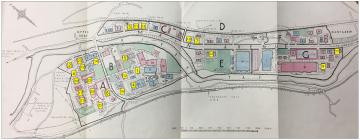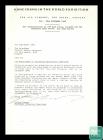Gellir lawrlwytho cynnwys at ddefnydd anfasnachol, megis defnydd personol neu ar gyfer adnoddau addysgol.
Ar gyfer defnydd masnachol cysyllwch yn uniongyrchol gyda deilydd yr hawlfraint os gwelwch yn dda.
Read more about the The Creative Archive Licence.
Disgrifiad
These undated and unsigned typed pages recount the history of the Newport (MON) Hebrew Congregation, from its founding in 1859 to the consecration of the Risca Road Synagogue in 2004. The author quotes from the history of the congregation titled, The First Hundred Years, printed in the program of the 1959 thanksgiving service.
The author of these pages relates the early years of the Newport congregation to his experiences in London, where the congregants also initially held services at private houses, then proceeded to hire a hall, and finally built a Synagogue in Belmont. Similarly, in Newport, for the first ten years the community held services at private residences until the synagogue on Francis Street was built in 1869 and consecrated in 1871. The document also notes that in 1871, the congregation received from Sir Charles Morgan, Lord Tredegar, a plot of land on the grounds of St. Woolos cemetery to be used as a Jewish burial ground. This information, however, is erroneous as a deed that conveyed a plot of land from Lord Tredegar to the Trustees of the Jewish Synagogue for building a Jewish burial ground was actually signed on 22 May 1860 (public record office).
At the turn of the century, the Newport minister, Rev Michaelson is noted to have been encouraged to visit the budding Jewish communities in Tredegar and Brynmawr, which were later incorporated into the Newport (MON) Hebrew Congregation. In 1905, Mr Alexander Hyams who went on to serve the community for 40 years, was appointed as a preachers and a headmaster of the Hebrew School.
The author notes the arrival in 1910 of Rev Abraham Snadow from Abertillery as one of the important landmarks of the history of the congregation. Rev Snadow remained in the community for sixty years and his 35-year-long cooperation with Mr Hyams is described as wonderful and harmonious.
The First World War is mentioned in relation to the death of a member of the congregation, Captain Nathan Harris, after whom the social hall on Queen's Hill Crescent was named after it was erected in 1922. The Nathan Harris Memorial Hall acted initially as a social space and a Hebrew school after the number of children in the community skyrocketed during the war as a number of Londoners afraid of Zeppelin raids took refuge in Newport.
In 1927, Bertrand Jacobs together with his siblings donated the congregation a cemetery house in memory of their parents. The community now was now in possession of three buildings. However, after the war, the community started to dwindle as the depression led a significant number of Jews to leave Newport. In the 1930s, the congregation was forced to sell the Francis Street Synagogue and convert the Nathan Harris Memorial Hall into a new synagogue.
During the Second World War, the community was active in helping Jews facing persecution and in rallying community spirit in and around Newport. After the war the membership continued to fall and with few pupils left to attend the Hebrew school, Mr Hyams tendered his resignation.
The membership dwindled and in 1994, the Queen's Hill Synagogue was put for sale. It was eventually sold in 1997 and the congregation moved to the Tahara House, that is, the cemetery building on Risca Road. The expansion work on the house was completed in 2003 and the building was consecrated in 2004, which is when the pages were presumably written.
The story ends with the author noting that the community is so small, members of the Cardiff community are needed to form a minyan (carry out certain services that require the presence of ten adult men).
Newport Monmouthshire Hebrew Congregation was founded in 1859 by orthodox Jews meeting at a temporary synagogue in Llanarth Street. A synagogue at Francis Street was opened in 1869 and consecrated by the Chief Rabbi Dr Herman Adler in 1871. In 1934 the congregation moved to the Nathan Harris Memorial Hall in Queen’s Hill which was converted to a synagogue. In 1997 this synagogue was closed, and the congregation moved to the Prayer House by the Jewish Burial Ground on Risca Road. Within 20 years the congregation had dwindled to a few members able to attend and this too had ceased to hold services.
Sources:
“History of our Shul. The First Hundred Years", published by Newport Congregation in 1959;
Oral history interviews with members of the Newport (MON) Hebrew Congregation, recorded in 2018 by JHASW.
Depository: Gwent Archives.


















Oes gennych chi wybodaeth ychwanegol am yr eitem hon? Gadewch sylwad isod
Sylwadau (0)
Rhaid mewngofnodi i bostio sylw